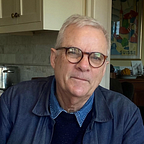Home ground
By the time I was six, I’d circumnavigated the world by ship. Much of what I saw no longer exists. The architect-designed house my parents built in suburban New Jersey in 1954, although a prime example of mid-century modernism, was torn down 45 years later. The only house of my childhood I can still visit is the one in which my late cousin also grew up. My great-grandfather’s summer house, where I stayed as a child, is nearby. I saw it again in May 2016, and my late cousin’s daughter lives on its grounds.
I arrived in Berkeley in March 1969, after driving out from St. Louis for spring break. One of our party, from San Francisco, stopped the car at the top of the Berkeley Campus. I can’t really say, “I knew I would live here,” but it feels true.
I sometimes say that I knew immediately that my wife and I would marry when I first met her, but the reality is that I felt we knew each other. She first moved to the block we live on in 1968. After our first son was born, we moved to the building that her parents owned. Later, they left San Francisco and joined us. In 1984, we bought a 1902 Victorian pattern house, made to look “shingle style,” as was popular when it was built by Charmaine Kittredge. Her father, a Los Angeles hotel developer, built Berkeley’s Shattuck Hotel. She went on to marry Jack London. While compact, the house has a Victorian floor plan with a foyer and four small bedrooms upstairs. A previous owner added to the kitchen and built a large deck in 1968. There’s a 1902 shed in the back.
From the room in which I sleep, I can see from the Golden Gate north to Angel Island and the coastal range past Mount Tamalpais. I consider this beloved view to be part of the house — an assertion that’s disputed by advocates for higher density in Berkeley. Located four blocks uphill from what was once a main streetcar route, the house is close to shops, cafés, and a renowned restaurant, Chez Panisse. It’s become “European” as local cuisine and markets have evolved in parallel with the region’s agriculture and viniculture.
But “Progress” (capital “P”) is constantly on the hunt to wreck this idyll. The region suffers from fragmentation, and each fragment imagines it can solve the region’s problems alone. The rise of the tech sector has created a multi-tiered economy, with the lower tiers steadily losing out. Young professionals of my acquaintance are leaving for places like Portland and Salt Lake City.
And this is the Left Coast, a haven of old lefties. The politics are complicated, often libertarian rather than progressive. (Tech-progressive, one could say.) The diverse human mix feels like the future, but other aspects of it lag behind. The economy is the size of the Netherlands (in a state with an economy bigger than France), but there’s a pervasive lack of public investment — austerity amid vast wealth — and a public sector that’s both entitled and ineffective. The region’s fragmentation means that reform is very difficult to enact.
In 1989, I visited a friend on sabbatical in Tokyo. He lived in Mejiro, a district along the circle line that divides the city’s inner and outer wards. In the 11 days I stayed there, I came to love the texture of the neighborhood, which was dense but low. Someone told me the average height of Tokyo then was 1.3 stories. I imagine that Berkeley has a comparable statistic.
When I heard this, I thought that adding density in Tokyo meant increasing it modestly at a city scale— something that was going on in the neighborhood around us. In fact, our three-story building was on the site of several single-family, probably single-story houses. It fit compatibly with its surroundings. Not every building on the narrow street needed to be redeveloped, and the process, instigated by owners in the immediate community, happened slowly. Slow is a good tempo at city scale, because the size of a city multiplies these small acts so they make a difference. Slow makes allowance for the character of a place. In contrast, most urban development is big and glacial — adding prohibitively to cost, discouraging local initiative, and disregarding scale.
Slow is made possible by a shared consensus. The pattern houses that gave rise to much of Berkeley were densely sited, modest, and affordable to young families. Most were built by small-scale, locally based entrepreneurs. Zoning reflected this consensus; now it doesn’t. A step was missed, and building and owning property became politicized. This is a recipe for corruption.
(This is the fourth of 12 brief, personal essays, “After Rilke.”)
